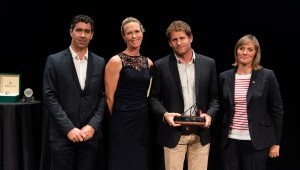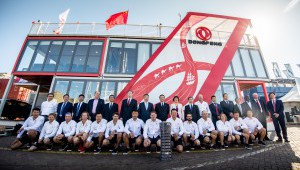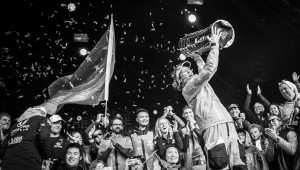About seven kilometres out of the centre of the Portuguese capital Lisbon, there is an old fish market that has been converted into a marina with the fish sheds now used for yacht re-fit work.
It is there that the Volvo Ocean Race has set up its official Boatyard – a comprehensive facility that provides the maintenance and repair processes for all the yachts entered in the 2017-18 race.
In the build-up to the start from Alicante next Autumn this also the place where the seven boats used in the last race in 2014-15 are going through a complete re-fit.
The first boat into the Boatyard is Dongfeng which arrived in Lisbon in late September when skipper Charles Caudrelier and a training crew delivered her from Gothenburg in Sweden via Lorient in France.
By the time the red and white Volvo Ocean 65 thoroughbred was lifted out of the water, and its keel and rig removed, it had sailed approximately 60,000 nautical miles since being launched in December 2013.
This mileage was made up of the Volvo Ocean Race itself – when Dongfeng Race Team finished third overall – plus all the training and other racing in the build-up and then some corporate and other sailing after the race.
“After 60,000 miles a lot of things wear out, a lot of things fatigue,” he said. “Some of it is cosmetic and some of it is a question of reliability but all the systems in the boat need a major overhaul including the keel hydraulics, all the electrical systems, the plumbing the communications gear – you name it.” Neil “Albert” Graham, the Technical Director of Dongfeng Race Team
After the equivalent mileage of sailing twice around the world, and having been pushed hard almost all the time by a crew that wanted to win, the boat and its fittings are in need of a full re-fit as Neil “Albert” Graham, the Technical Director of Dongfeng Race Team explains.
Not everything on the boat is replaced as new however. Some of the gear - for example the keel rams, the hydraulic pumps and the steering system – has been built to last more than twice as long as its lifespan to date and these components are being overhauled and serviced before being re-installed rather than scrapped.
But other components are too delicate to re-use. “More vulnerable things are replaced like all the wiring,” said Graham. “About 80% of all the electrical components are pulled out and replaced – navigation equipment, junction boxes, control boxes, instrument displays. The onboard computers are being replaced as is the media system and the satellite dome at the back.”
On deck all the fittings are removed and the hull and deck is sanded back to bare carbon before being re-primed and then painted in Dongfeng’s new livery which will be revealed when she emerges from the re-fit in early January.
The deck gear is then re-installed while all the running rigging is replaced along with new sails and a newly refurbished mast. Along the way, everything – the mast, the deck, the hull, the keel - is checked for signs of wear and tear using ultrasound surveying.
The work is all carried out by the Volvo Ocean Race Boatyard team and everything they do to Dongfeng has to be mirrored on all the other boats. As identical one-designs, the Volvo Ocean 65s have to be treated in exactly the same way as each other the same and the same standards in terms of what is overhauled or replaced have to be applied to each boat in turn.
“My role is to check that a reasonable standard is being maintained in all the work that they are doing to the boat but also analysing the processes that they employ to make sure that these are standardised across all the boats,” said Graham.
“It’s not dissimilar to a normal re-fit of a one-off boat except that you are not keeping an eye on the accounts because, like all the other teams, we are paying a fixed lump sum for the Boatyard as part of our race entry,” he added.
To all intents and purposes when the gleaming new Dongfeng emerges into the sunshine again in January, she will be an (almost) new boat again. She is likely to be a little bit heavier than she was when first launched because a small amount of water will have soaked into the hull, but Graham is fully expecting the seven old boats to emerge in 2017 once again within a few kilos of each other.
“They are weighed during the re-fit at the same point as during the original build – when all the systems are back in and the deck gear is back on. The measurers will wait until they have the full range of weights in the fleet before adding correctors if necessary,” Graham explained.
During the last race there were one or two modifications that crept into the boats in fittings that were not regarded as critical to overall performance. These included items like grab rails inside the cabin, sheet stowage bags in the cockpit and fittings around the galley. This time the re-fit is standardising even these elements, using the best solution from the various boats last time.
“The Volvo was a one-design race in 2014-15. This time they are actually making it even more one-design that last time!” noted Graham.














